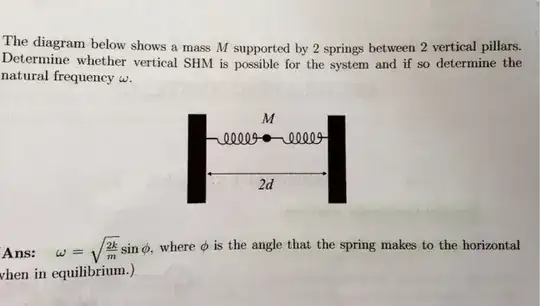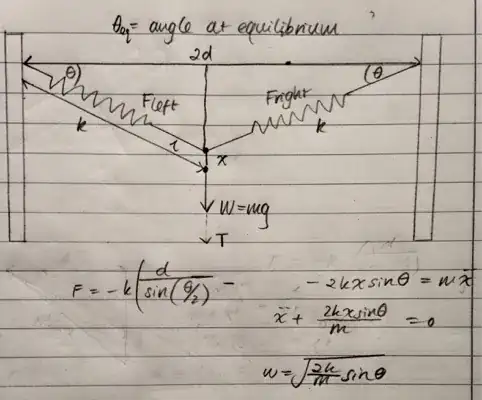
The problem is detailed above. I have worked through problems involving SHM in the horizontal plane, but unsure how to go about it vertically. I know the weight component would need to be incorporated...
 Thanks so much for helping!! :)
Thanks so much for helping!! :)

The problem is detailed above. I have worked through problems involving SHM in the horizontal plane, but unsure how to go about it vertically. I know the weight component would need to be incorporated...
 Thanks so much for helping!! :)
Thanks so much for helping!! :)
The net force acting on the mass M will be $$F=-2kx\sin\phi$$
Here,x is extension of spring,which can be found out by
$$d=(x+d)\cos\phi$$ $$2d\sin^2\frac{\phi}2=x\cos\phi$$ $$2d\cdot (\frac {\phi}2)^2=x$$...Considering very small oscillations.
Also, $$F=M\frac{d^2((x+d)\sin\phi)}{dt^2}=M\cdot d\cdot\frac{d^2(\tan\phi)}{dt^2}$$
If,we consider the oscillations to be small,then $$\tan \phi \approx \phi,\sin \phi \approx\phi$$
Therefore, $$M\cdot d\cdot\frac{d^2(\phi)}{dt^2}=-2kx\phi$$
But,I am getting
$$\frac{d^2(\phi)}{dt^2}=\frac{-k\phi^3}{M}$$ which is not simple harmonic motion.Also,how can the extremal angle be present in $\omega$ as $\phi$ is changing continuously?
Since this is a 1D problem the frequency of small oscillations is simply given by the relation $$\omega^2 = \frac1m U''(x_0),$$ where $U(x)$ is the potential energy of the system and $x_0$ the equilibrium position. This is explicitly given by $$U(x) = mgx + k\left(\sqrt{x^2+d^2}-d\right)^2,$$ and from here one finds $$\omega^2 = \frac{2k}m\left(1-\frac dl + \frac{dx^2}{l^3}\right),$$ where $l^2 = x^2 + d^2$ for convenience. Observe that $d/l = \cos\theta$ and $x/l = \sin\theta$, so that when $x=x_0$, the angle $\theta$ is that of equilibrium, and the above equation is seen to become $$\omega^2 = \frac{2k}m\sin^2\theta.$$
It does not seem give simple harmonic motion. This can be seen by examining the Lagrangian $$ L = \frac{1}{2} m \dot{x}^2 - 2 \frac{1}{2}k \left(\sqrt{d^2 + x^2} -d \right)^2$$ The factor of two in front of the potential comes from the fact that there are two springs. Now in the limit of $x \ll d$, one has $$ \left(d \sqrt{1+x^2/d^2} -d \right) \approx \frac{1}{2}\left( \frac{x^2}{d}\right)$$ In which case the Lagrangian is $$ L = \frac{1}{2} m \dot{x}^2 - \frac{1}{4}k\left(\frac{x^4}{d^2}\right)$$ Finally, the equation of motion is $$m\ddot{x} = \left(\frac{-k}{d^2}\right)x^3$$ The anharmonicity ultimately comes from the square root dependence of the restoring force on the displacement of the mass $m$.